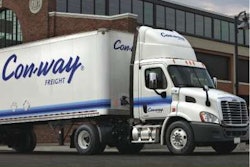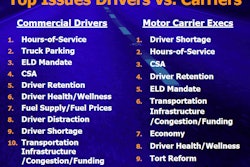 Jonah Hill plays the character in “Moneyball” who convinces the manager played by Brad Pitt that he should recruit players based on a close examination of their personal data.
Jonah Hill plays the character in “Moneyball” who convinces the manager played by Brad Pitt that he should recruit players based on a close examination of their personal data.In July last year, Overdrive‘s Max Heine reported on a variety of ways carriers had begun to utilize performance-related and other data with predictive modeling to assess and coach driver safety, efficiency and productivity, a sort of “Moneyball” approach to driver retention — useful in helping keep drivers around longer, among other potential benefits cited by the fleets in question. At the recruiting and retention conference held last week in Nashville, Tenn., by Conversion Interactive and the Truckload Carriers Association, reps of the Omnitracs company showed how so-called “predictive analytics” can be utilized not only for retention — but recruiting.
Your next lease or employment application could well hinge in part on whether such predictive recruiting models suggest you’re a good fit for whatever fleet you hope to join forces with — or not.
Omnitracs CTO Dan Speicher detailed the company’s predictive “recruiting model,” which builds on work by the FleetRisk Advisors predictive analytics business that Omnitracs acquired several years ago.
Omnitracs studied “1,725 drivers to identify patterns in their data which relate to information on the driver application,” Speicher said, identifying key elements to determine how strongly they correlated to a driver’s likelihood to “stay with your organization.” Omnitracs crafts predictive models on a customer-to-customer basis, meaning one fleet may want to be able to judge a certain set of likely outcomes different from the next.

Speicher called those outcomes each company’s “pre-determined success criteria,” further asking the question the company’s recruiting model hopes to answer for any fleet: “What tendencies in [a driver’s] career path that are captured are most like those who are successful in the organzation today?”
How it works: The driver applicant is evaluated by the Omnitracs analytics engine, which analyzes information such as gaps in employment, prior jobs, experience, licensing information, endorsements, CSA-related metrics derived from driver Pre-Employment Screening Program reports, accidents, criminal history and the like. The system then scores the driver in various areas based on the model in place at any given fleet.
All-owner-operator John Christner Trucking has utilized Omnitracs Analytics’ retention modeling platform, among other data analytics, as a means toward better relationships with its leased drivers in the recent past. While VP Shannon Wright hasn’t put in place the recruiting model, he suggested any improvement in current applicant-screening efforts would be advantageous.
“I interview every single driver before we on-board them,” he said, amounting to 1,200-1,500 conversations annually. Oftentimes, his standard gut-check after a very good interview — the driver is “proud of what he does, he presents himself as such,” Wright said — proves dead wrong.
With an effective predictive analytics model on the front end, said Speicher, carriers would at least “have a demonstration of past behavior that is at least somewhat objective. Maybe you treat them or train them differently based on the predictability of certain outcomes.”
At once, he added, the pieces of information included in the recruiting engine are “statistically sound in predicting things, but they’re not an absolute. But neither is hiring someone on an interview alone.”













